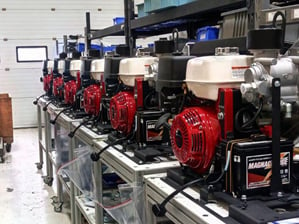VMAC G30 Gas Driven Air Compressor Installation Best Practices
 You know better than anyone that being an effective truck upfitter requires a unique set of skills: understanding machinery and its mechanical and electrical components, knowledge of customer needs, and problem-solving capacity. Customers require all tools and equipment to fit and perform optimally on their job sites.
You know better than anyone that being an effective truck upfitter requires a unique set of skills: understanding machinery and its mechanical and electrical components, knowledge of customer needs, and problem-solving capacity. Customers require all tools and equipment to fit and perform optimally on their job sites.
The G30 is a fantastic addition to many service trucks, providing 30 CFM of compressed air at 100% duty cycle at an affordable price. They are also quick and easy to install on most vehicles with a few caveats, which we explain below.
Keep The Oxygen Flowing In The Enclosure
Oxygen is required to operate gas combustion engines, including the G30's GX390 engine. If there is a lack of oxygen flow around the engine, there will be issues.
Fortunately, engines like the GX390 can still be enclosed, but maximizing the space around the engines will prevent overheating or stalling.
The air compressor system needs oxygen as well. The air compressor front and WHASP tank side must remain free of obstructions so enough oxygen can get into the system and keep it running.
The following diagram displays the air flow requirements of the G30:

G30 Air Flow Best Practices:
- Leave a minimum of two sides open – one of these sides should always be the WHASP tank side.
- Leave the front of the machine clear of obstructions.
Use Ventilation To Avoid Exhaust-Related Stalls
 Just like vehicle exhaust, the byproducts of spent gasoline need to be exhausted away from small gas combustion engines because exhaust contains carbon monoxide, which suffocates the engine.
Just like vehicle exhaust, the byproducts of spent gasoline need to be exhausted away from small gas combustion engines because exhaust contains carbon monoxide, which suffocates the engine.
Exhaust is never a concern if the engine is out in the open. However, proper exhaust routing is required if the engine is near walls or other equipment.
Adequate ventilation is also vital for proper operation and safety. When a system is not adequately cooled, it can lead to oil deterioration, increased oil consumption, power loss, reduced life, or failure of the engine or compressor.
G30 Ventilation Best Practices:
- Ensure engine exhaust vents away from the engine/compressor intake.
- Use an adequately sized exhaust pipe for the extension required.
Follow The Installation Manual
Equipment installation manuals help ensure optimal performance and operator safety. It’s best to review manuals before starting installations, follow the instructions throughout installations, and contact the manufacturer if anything needs clarification.
G30 Manuals Best Practices:
- Installation, Owner’s and Service Manuals are shipped with every G30 air compressor.
- Ensure manuals are shared with customers when installations are complete.
Protect Operators’ Health & Safety
 The discovery stage of the sales process, working with customers to identify their unique requirements, should be taken seriously.
The discovery stage of the sales process, working with customers to identify their unique requirements, should be taken seriously.
The G30 air compressor is not an appropriate system for people who work within a van’s cargo area. Gas engines quickly consume oxygen in any small space and replace it with odorless and potentially deadly carbon monoxide. Attempts at proper ventilation rarely work as intended and can result in death.
Ensuring customers specify the right equipment for their jobs while maintaining continuous safe operation of equipment is vital to everyone's personal and business health and well-being. Consider all safety precautions when helping customers through this process.
The final and most important stage of the sales process is delivery of the upfitted vehicle to the customer. During final delivery, customers need proper training on the installed equipment, including any potential safety hazards.
G30 Health & Safety Best Practices:
- NEVER install gas driven air compressors inside any area where operators work, such as a commercial van cargo area.
Follow the best practices above to ensure your customers are 100% satisfied with their G30 installation. If you have any questions during the installation process, please contact VMAC tech support.
